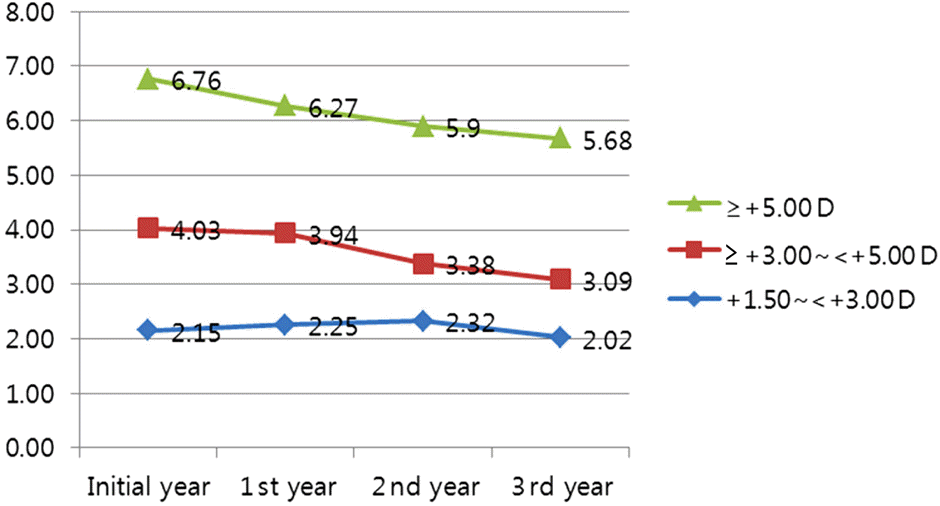초록
Purpose:
To analyze the long-term changes of hyperopic refractive error in patients with refractive accommodative esotropia.
Methods:
We retrospectively reviewed the medical records of 54 patients with accommodative esotropia who underwent at least 36 months of follow-up and had hyperopia more than +1.50 diopter (D). The patients were divided into groups according to the degree of hyperopia: +1.50~<+3.00 D, ≥+3.00~<+5.00 D, and ≥+5.00 D, the age of their first hyperopic glasses prescription: under two-years old, between two to four-years old and older than four years old, whether or not they had amblyopia, the degree of astigmatism: <0.75 D, ≥0.75-<1.25 D, and ≥1.25 D and divided into two groups according to the degree of stereopsis: ≤400 sec and >400 sec. The divided groups were than retrospectively reviewed if they influenced the refractive error at the third year of follow-up using Fisher’s exact test, paired t-test, Wilcoxon’s signed-ranks test, Mann-Whitney U test, Kruskal-Wallis H test, and ANOVA ( p < 0.05).
Results:
The mean follow-up period was 103.72 ± 41.82 months for refractive accommodative esotropia. Patients with a greater initial hyperopic refractive error showed a significant tendency towards emmetropization with a higher rate of hyperopic decrease ( p < 0.001), regardless of the hyperopic refractive error. Statistical differences were not observed in patients who started wearing glasses after four-years old, patients with amblyopia, patients with a large degree of astigmatism, and patients with poor stereoacuity.
Conclusions:
Long-term changes of hyperopic refractive error in accommodative esotropia showed a significant decrease when initial hyperopic refractive error was high. Wearing hyperopic glasses at an older age and visual functions such as amblyopia, large degree of astigmatism, and poor stereoacuity may influence emmetropization.
Go to : 
References
1. Von Noorden GK. Binocular vision and ocular motility. 6th ed.St Louis: Mosby;2002. p. 311–55.
2. Cho YA, Mun CJ. Treatment of Near Esotropia with High AC/A Ratio. J Korean Ophthalmol Soc. 1995; 36:2231–6.
3. Rutstein RP, Marsh-Tootle W. Clinical course of accommodative esotropia. Optom Vis Sci. 1998; 75:97–102.

5. Kim MM, Cho YJ. The factors influencing on binocularity in accommodative esotropia. J Korean Ophthalmol Soc. 1997; 38:1847–51.
6. Choi MY, Chang BL. Binocularity in refractive accommodative esotropia. J Korean Ophthalmol Soc. 1999; 40:1663–70.
7. Berk AT, Koçak N, Ellidokuz H. Treatment outcomes in refractive accommodative esotropia. J AAPOS. 2004; 8:384–8.

9. Yang H, Chang YH, Lee JB. Clinical features of refractive accommodative esotropia and partially accommodative esotropia. J Korean Ophthalmol Soc. 2004; 45:626–30.
10. Choi KS, Chang JH, Chang YH, Lee JB. Occurrence and risk factors of decompensation and additional treatment in refractive accommodative esotropia. J Korean Ophthalmol Soc. 2006; 47:121–6.
11. Koretz JF, Rogot A, Kaufman PL. Physiological strategies for emmetropia. Trans Am Ophthalmol Soc. 1995; 93:105–18. discussion 118-22.

12. Raab EL. Hypermetropia in accommodative esodeviation. J Pediatr Ophthalmol Strabismus. 1984; 21:P64–8.
13. Atkinson J, Anker S, Bobier W, et al. Normal emmetropization in infants with spectacle correction for hyperopia. Invest Ophthalmol Vis Sci. 2000; 41:3726–31.
14. Na SJ, Choi NY, Park MR, Park SC. Long-term follow-up results of hyperopic refractive change. J Korean Ophthalmol Soc. 2005; 46:1704–10.
Go to : 
 | Figure 1.Spherical equivalent refractive error according to the time of follow-up. D = diopter. |
Table 1.
Clinical characteristics of children diagnosed with refractive accommodative esotropia
Table 2.
Spherical equivalent difference according to initial degree of hyperopia
Table 3.
Spherical equivalent difference according to age at which spectacles were prescribed
Table 4.
Spherical equivalent difference according to astigmatism
Table 5.
Spherical equivalent difference according to amblyopia




 PDF
PDF ePub
ePub Citation
Citation Print
Print


 XML Download
XML Download